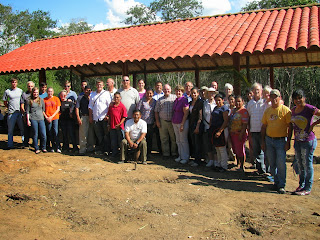Written by Tim Ramsey, son of Chuck Ramsey
Over 60 years ago, on July 4,
1953, Chuck and Jean Ramsey stepped on to a plane and left the U.S. They felt
they had been called by God to spend their lives among the people of Bolivia.
Just 24 hours ago, the last of that intrepid duo embarked on a new journey. At
10:43 a.m. on Thanksgiving morning, Chuck breathed his last and stepped into
eternity. He was preceded by Jean three years earlier.
What happened between 1953 and 2013 could fill volumes of books. Such books would share stories of adventures of living by faith among a once-violent people group, the Ayoré. It would tell of lives poured out for the Gospel in remote settings, as well as in the growing cities of Bolivia. It would tell of failures, yes; my parents were human, but there were also victories. Most of all, it would be about those changed for eternity as a result of the choices Chuck and Jean made.
At LATCOM, we have files and files of material, tens of thousands of photos, and miles of videotape that document Chuck and Jean’s lives and ministries. It will be my responsibility and honor, along with my four siblings, to weed through some of these mementos and cull out the essence of Chuck and Jean. Yet the task will not be too difficult, for we all know that our Dad and Mom chose to go to Bolivia for one reason: to tell others the Good News about Jesus Christ.
It is a fact worth saying that
God used Chuck and Jean as His vessels to shine His light into the homes and
lives of many, many people.
You know, missionaries are not
“saints”. They are merely ordinary Christians with an extraordinary calling,
given strength by an extraordinary God. God is the hero of this story – not
Chuck, not Jean, and certainly not LATCOM. It is God Who called and used my parents
as ambassadors. It is God Who gave them focus and strength and comfort in the
jungles. It is God Who caused them to teach His Word, Who helped them provide
medical and dental care to others, and Who compelled them to begin so many
ministries (medical and dental; video ministry to high schoolers; the first
Evangelical University in Bolivia; radio stations; and programs, to name just a few).
I think there are only three
things we can touch and know in our earthly journey that have eternal value:
Jesus, God’s Word, and people. All the rest is temporary at best. My Dad’s
legacy to me is an awareness of these three things. Let me elaborate.
Jesus: The first
and most important thing in the world that has eternal value is Jesus Christ.
Death cannot hold Him. It is only through Him that we have eternal life and any
measure of hope. Chuck and Jean lived their lives with a realization of this
value, and they would want you to know that the most important decision one can
make is whether or not to accept Jesus as Lord. Accepting Jesus enables one to
give up his fierce commitment to making life work and to yield to the guidance
and leadership of a loving Savior.
Chuck and Jean’s example of doing just that is a challenge to all of us to do
the same.
God’s Word: In her
later years at Monte Blanco Camp, Jean spent hours every day pouring over her
much-worn Bible. I wish you all could have known her in those final years, for
all that time in God’s Word softened her, changed her, and drew her to love others in new ways right up until the day
she went to be with the Lord. Psalm 119:105 tells us that God’s “word is a lamp
to my feet and a light for my path”. We can trust God’s Word to guide our
lives. The legacy we five siblings have is one of cherishing the Word of God,
of memorizing it and seeking to apply it in our everyday lives. Jesus said to
His disciples that “Heaven and earth shall pass away, but my words shall never
pass away” (Matthew 24:35). This is because immersion in God’s Word changes
hearts.
People: Finally,
my parents taught us that people are what matter, not possessions or position.
We kids saw our parents observe this principle every day as people came to the
door seeking help or advice from them. Whether it was a shot of penicillin, a
ride to town, or some money, our parents were ready to drop everything at a
moment’s notice to tend to the needs of others. And in the process of tending
others, Mom and Dad often shared the Gospel as the reason why they were so
available.
Chuck and Jean’s legacy to the world (and to their five children as well as more generations) was this: Love Jesus. Follow biblical teachings. Give to others. It is an eternal legacy.
If Chuck or Jean Ramsey touched
your life in some way, we’d love for you to share in honoring these faithful
servants of Christ at a memorial service and lunch in their honor on Saturday,
Feb. 1, 2014. Full details are below and are also available at www.latcom.org.
Additionally, online condolences may
be offered at www.cunninghamfh.com.
























.svg.png)







